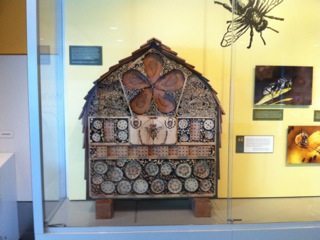 One of the best websites for information on nesting resources is the USDA lab at Logan. Follow this link.
One of the best websites for information on nesting resources is the USDA lab at Logan. Follow this link.
Cavity nester boxes
Nesting blocks can be made by drilling nesting holes between 3/32” and 3/8” diameter, at approximate ¾-inch centers, into a block of preservative-free lumber. The holes should be smooth inside, and closed at one end. Holes less than ¼-inch diameter should be more than 3 inches deep; holes ¼-inch or larger should be more than 6” deep. The height of the block is not as important, but 8 inches or more is good. Fix the nest to a firm support. Nest sites should be sunny but sheltered from wind and rain. Facing blocks into the morning sun will help nesting bees to warm up for flight earlier in the day. In desert areas, adobe blocks can be drilled instead of wood. The one on the right is one that we built with 4th graders at Peralta Elementary School in Oakland. It's on display at the Oakland airport!
Stem or tube bundles.
Some plants, like teasel, bamboo, and reeds, have naturally hollow stems. Cut the stems into 6 to 8 inch lengths, making sure one end is closed; tie fifteen to twenty pieces into a bundle, with the closed ends together.
Bumble Bee Box
Find or build a simple wooden box, about 7 inches on each side, made from preservative-free lumber. Drill a few ventilation holes near the top (covered with a screen to deter ants) and some drainage holes in the bottom. Make an entrance tunnel from ¾-inch plastic pipe, marked on the outside with a contrasting color, and fill the box with soft bedding material (for example, upholsterer’s cotton). The box must be weather tight; the larvae may become cold in a damp nest, and mold and fungus will grow.
Place the box in an undisturbed site, where there is no risk of flooding. The box should be on or just under the ground. If you bury it, extend the entrance tube so it gently slopes to the surface. Put your nesting box out before you first notice bumble bees in the spring. There is no guarantee that bees will use your box; only about one in four bumble bee boxes get occupied. If it has no inhabitants by late July, put the nesting box into storage until next spring.
